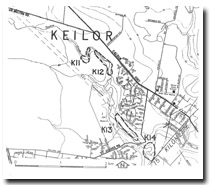K12 Taylors Creek, Taylors Lakes - Silcrete Cave
|
This information has been developed from the publications:
|
| Location | Keilor - 073240. Former City of Keilor. Valley of Taylors Creek near Hillview Court, 2 km northwest of Keilor. |  Silcrete cave |
Access | Hillview Court. | |
Ownership | Crown land managed by the former City of Keilor | |
Site Description | Taylors Creek Cave lies in the channel of Taylors Creek and consists of a single low chamber 12 m long and 5 m wide. It has been excavated in a friable sandstone bed of the Red Bluff Sand that underlies a resistant indurated layer of silcrete. | |
The silcrete is part of an irregularly shaped hummock that outcrops across the valley of the creek and is overlain by basalts of the Newer Volcanics. Smaller outcrops of silcrete and silcrete rubble occur both upstream and downstream of the main outcrop. The silcrete has been formed by silica enrichment and cementation of beds of the Red Bluff Sand, in a zone of weathering beneath the lava flows. | ||
The cave entrance is 8 m wide and faces upstream, although it is partially blocked by boulders and logs. The roof of the cave slopes downstream and reaches the pool of water that normally occupies the cave floor. The cave is drained by a narrow tunnel 1 m long opening downstream, and during normal flow, this is sufficient to maintain drainage. During high flow, inwashed debris constricts through flow and water is forced to escape through small holes in the cave roof. In floods, water probably overflows and covers the silcrete pavement and the outer roof of the cave. | ||
The site includes the valley slopes adjacent to the cave, the valley for some distance upstream and downstream of the cave, and part of the valley of the small downstream tributary where there is a silcrete outcrop but no cave development. | ||
Significance | State. Taylors Creek Cave is an unusual example of cave formation formed by a combination of piping and stream erosion. It is the only Victorian silcrete cave that has been described in detail. The exposures of silcrete, Red Bluff Sand and Newer Volcanics are clear and the relationships between the formations is readily discernible. The site is an excellent example of a landform complex related to various geological materials and to both relict and active processes. | |
Management | Class 1. The site is threatened by urban development and degradation of Taylors Creek. Up to this time, the site has enjoyed protection by its relative isolation but it is now surrounded by housing and properties back onto the upper valley slopes. The features of the site are robust and can tolerate substantial visitor use, but the quality of the site will deteriorate rapidly if water quality further declines and building and domestic refuse continue to accumulate at the current rate. It will be necessary to maintain an active management policy to ensure that degradation of the stream environment does not reach unacceptable levels. Delineation of a public reserve for informal open space activities without facilities would be an appropriate use for the site. Adjacent property owners should be informed of the significance of the site and encouraged to participate in its conservation. | |
References | Webb, J.A. and Joyce, E.B. (1983). Taylor Creek Silcrete Cave. Helictite 21:25-32 | |

K12


